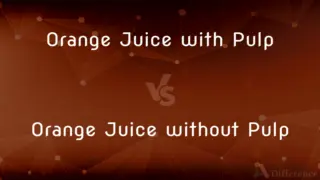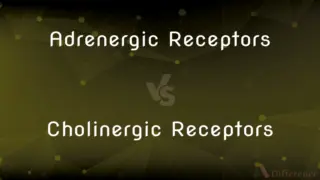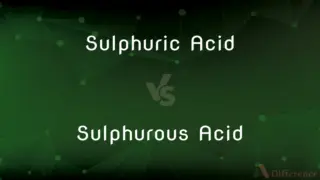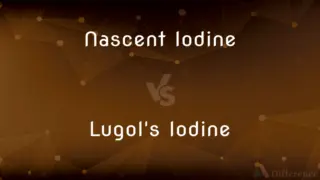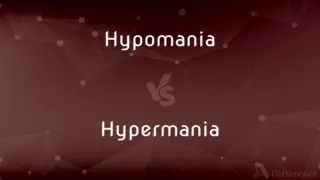Photosynthesis vs. Cellular Respiration — What's the Difference?
Edited by Tayyaba Rehman — By Fiza Rafique — Published on November 6, 2023
Photosynthesis is the process plants use to convert sunlight into energy; cellular respiration is how cells break down glucose and release energy.

Difference Between Photosynthesis and Cellular Respiration
Table of Contents
ADVERTISEMENT
Key Differences
Photosynthesis and cellular respiration are fundamental processes in the realm of biology. While photosynthesis involves converting sunlight into energy stored in glucose, cellular respiration is the process that takes this glucose and breaks it down to produce energy in the form of ATP.
Photosynthesis primarily occurs in the chloroplasts of plant cells, capturing sunlight and using its energy to synthesize glucose from carbon dioxide and water. Cellular respiration, on the other hand, mostly takes place in the mitochondria of cells, where glucose undergoes a series of reactions to produce ATP, carbon dioxide, and water.
Another major distinction between photosynthesis and cellular respiration lies in the energy transformation. Photosynthesis is an endergonic process, meaning it absorbs energy from its surroundings. In contrast, cellular respiration is exergonic, as it releases energy.
A beautiful reciprocity exists between these two processes. The products of photosynthesis, namely glucose and oxygen, are the very reactants needed for cellular respiration. Conversely, the products of cellular respiration, carbon dioxide and water, are utilized as reactants in photosynthesis.
To encapsulate, while photosynthesis and cellular respiration serve the mutual purpose of energy conversion and transfer in living organisms, they operate in opposite directions and in different cellular compartments, complementing each other's functions.
ADVERTISEMENT
Comparison Chart
Location
Occurs in chloroplasts.
Takes place in mitochondria.
Primary Function
Converts sunlight into glucose.
Breaks down glucose to produce ATP.
Energy Flow
Endergonic (absorbs energy).
Exergonic (releases energy).
Major Reactants
Carbon dioxide and water.
Glucose and oxygen.
Major Products
Glucose and oxygen.
Carbon dioxide, water, and ATP.
Compare with Definitions
Photosynthesis
Photosynthesis is the process by which green plants create energy.
Through photosynthesis, plants sustain themselves and provide oxygen for animals.
Cellular Respiration
It utilizes glucose and oxygen to produce carbon dioxide and water.
Cellular respiration takes in essential nutrients and releases waste products.
Photosynthesis
Chlorophyll in plant cells facilitates photosynthesis.
The green pigment chlorophyll is essential for photosynthesis to occur.
Cellular Respiration
Cellular respiration is essential for all aerobic organisms.
For survival, humans heavily rely on cellular respiration.
Photosynthesis
Photosynthesis is vital for life on Earth.
Without photosynthesis, the Earth's oxygen levels would plummet.
Cellular Respiration
Cellular respiration breaks down glucose to generate ATP.
Cells gain energy through cellular respiration to function optimally.
Photosynthesis
It involves the conversion of sunlight into glucose.
Photosynthesis captures the sun's energy to produce vital sugars for the plant.
Cellular Respiration
It is an exergonic process releasing energy.
Energy is released during cellular respiration, fueling bodily activities.
Photosynthesis
It is an endergonic reaction requiring solar energy.
Photosynthesis uses sunlight to drive the energy-demanding process.
Cellular Respiration
Cellular respiration primarily occurs in mitochondria.
The mitochondria are often called the powerhouses due to their role in cellular respiration.
Photosynthesis
The process in green plants and certain other organisms by which carbohydrates are synthesized from carbon dioxide and a source of hydrogen (usually water), using light as an energy source. Most forms of photosynthesis release oxygen as a byproduct.
Photosynthesis
(biology) Any process by which plants and other photoautotrophs convert light energy into chemical energy,
Photosynthesis
Principally, oxygenic photosynthesis, any process by which plants and algae convert water and carbon dioxide into carbohydrates and waste oxygen using solar energy.
Photosynthesis
Also, non-oxygenic photosynthesis, used by purple and green bacteria, heliobacteria, and acidobacteria.
Photosynthesis
The process of constructive metabolism by which carbohydrates are formed from water vapor and the carbon dioxide of the air in the chlorophyll-containing tissues of plants exposed to the action of light. It was formerly called assimilation, but this is now commonly used as in animal physiology. The details of the process are not yet clearly known. Baeyer's theory is that the carbon dioxide is reduced to carbon monoxide, which, uniting with the hydrogen of the water in the cell, produces formaldehyde, the latter forming various sugars through polymerization. Vines suggests that the carbohydrates are secretion products of the chloroplasts, derived from decomposition of previously formed proteids. The food substances are usually quickly translocated, those that accumulate being changed to starch, which appears in the cells almost simultaneously with the sugars. The chloroplasts perform photosynthesis only in light and within a certain range of temperature, varying according to climate. This is the only way in which a plant is able to organize carbohydrates. All plants without a chlorophyll apparatus, as the fungi, must be parasitic or saprophytic.
Photosynthesis
Synthesis of compounds with the aid of radiant energy (especially in plants)
Common Curiosities
What's the primary purpose of photosynthesis?
Photosynthesis converts sunlight into glucose, providing energy for plants and oxygen for animals.
How are photosynthesis and cellular respiration related?
The products of photosynthesis (glucose and oxygen) are the reactants for cellular respiration and vice versa.
Where does cellular respiration mainly occur?
Cellular respiration primarily takes place in the mitochondria of cells.
What is the role of oxygen in cellular respiration?
Oxygen acts as the final electron acceptor in the electron transport chain, facilitating ATP production.
Why is photosynthesis considered endergonic?
It's endergonic because it absorbs energy (sunlight) from its surroundings.
What gas do animals provide that plants use in photosynthesis?
Animals produce carbon dioxide, which plants use in photosynthesis.
Do all organisms undergo cellular respiration?
All aerobic organisms undergo cellular respiration, but anaerobic organisms do not use oxygen in their respiration processes.
Can photosynthesis occur at night?
No, photosynthesis requires sunlight, so it doesn't occur at night.
Which organism performs photosynthesis?
Green plants, algae, and some bacteria perform photosynthesis.
How does photosynthesis impact Earth's atmosphere?
Photosynthesis produces oxygen and consumes carbon dioxide, influencing Earth's atmospheric composition.
What happens during the absence of oxygen in cellular respiration?
In the absence of oxygen, cells may undergo anaerobic respiration or fermentation, producing less ATP.
What is the main energy molecule produced in cellular respiration?
The main energy molecule produced is ATP (adenosine triphosphate).
Why is cellular respiration considered exergonic?
It's exergonic because it releases energy when glucose is broken down.
Which molecule captures sunlight in photosynthesis?
Chlorophyll, a green pigment in plants, captures sunlight.
How is glucose used in cellular respiration?
Glucose is broken down in a series of reactions to produce ATP, carbon dioxide, and water.
Share Your Discovery

Previous Comparison
Single Core vs. Dual Core
Next Comparison
Tomato Puree vs. Tomato PasteAuthor Spotlight
Written by
Fiza RafiqueFiza Rafique is a skilled content writer at AskDifference.com, where she meticulously refines and enhances written pieces. Drawing from her vast editorial expertise, Fiza ensures clarity, accuracy, and precision in every article. Passionate about language, she continually seeks to elevate the quality of content for readers worldwide.
Edited by
Tayyaba RehmanTayyaba Rehman is a distinguished writer, currently serving as a primary contributor to askdifference.com. As a researcher in semantics and etymology, Tayyaba's passion for the complexity of languages and their distinctions has found a perfect home on the platform. Tayyaba delves into the intricacies of language, distinguishing between commonly confused words and phrases, thereby providing clarity for readers worldwide.














